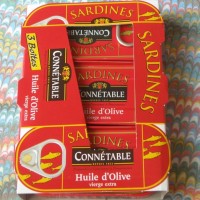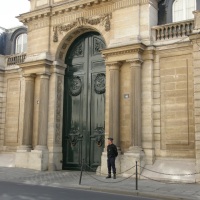You know how it is: you notice something properly for the first time, and for the next while, you see it everywhere. So it was with us and the cartoons of Voutch (real name: Olivier Chapougnot).
We had wandered along the Boulevard Port-Royal and decided to take the stairs leading down to one of the sunken streets that cross underneath, rue Broca. This led us to the Librairie Les Traversées at the bottom of the rue Mouffetard. We cannot resist a bookshop (alas – we struggle at the end of each visit with bags that are too heavy), so we went in to explore.
First, we noticed the postcards.
No kidding! You entered “in the port” not “at the port.”
Given our struggles with French prepositions, the caption appealed to us. So did the vultures with their laptop.
First you type “Serengeti,”press Enter, then “Satellite View,” Enter, then “Find,” click on “Gnu,” and in the menu, select “Recent deaths.”
Not far from the postcards were collections of the cartoons in books. An hour later, we emerged with – among other finds we couldn’t resist – two Voutch collections, several Voutch postcards to send to family and friends, and an album called Petit Traité de Voutchologie à l’Usage des Fans et Autres Voutchophiles Eventuels [Short Treatise on Voutchology for the Use of Fans and Future Voutchophiles] (Editions Cherche-Midi, 2015).
From then on, it seemed that everywhere we went, we began to notice Voutch cartoons. In magazines. On children’s books (some by him, some by other people).
And everywhere, the postcards, instantly recognizable.
I want to learn humility. I want to be the No. 1 World Champion in humility!
Clearly, a one-man industrial cartoon complex.
Two things struck us about the cartoons. First, the richly detailed landscapes and interiors in the background. And second, the peculiar habit of depicting people as modified cylinders with enormous noses.
The Petit Traité de Voutchologie provided some background on how Voutch developed this style. The book is in the form of a dialogue between Voutch and someone who may or may not be the author listed on the front; the story emerges in bits and pieces.
Voutch worked in the advertising industry for 15 years. In 1995, he’d had enough and decided to change direction. His first choice: marketing plastic boomerangs. (As the interviewer says in the book: “Non?…Sérieusement?” Voutch answers: “Sérieusement.”) Not surprisingly, this business did not, ahem, take off. So after some soul-searching, Voutch decided to try cartoons.
One problem: he needed a distinctive style. His early efforts at black-and-white New-Yorker-style cartoons were competent, but visually unmemorable.
Mr. Superman is on sick leave. I’m his replacement, Mr. Gonzales.
He tried adding some colour to these images with watercolour wash, but it made little difference. Then one day, a friend was looking at some of his artworks and noted that Voutch had a talent for gouache, which he had been using to paint landscapes.
A light bulb went on. Gouache is a type of water-based paint that creates opaque, rich colours. Voutch was comfortable with the medium, and it added greater depth to the images. At first he used it as colouring to fill in elements outlined in black.
Trust me: this time, it’s the right one.
Eventually, he got rid of the black outlines. Meanwhile, as he was developing his technique with gouache and adding texture and detail to the settings, his depiction of people was becoming more and more stylized: the noses kept getting bigger and the bodies kept getting more and more minimal. And yet each caricature had a distinctive personality.
You go out to buy bread, you disappear without the least explanation for 14 and a half years, and all you can find to say when you return is: the bakery was closed?
Gouache is not a medium for the impatient. It takes time to build up the layers. When Voutch has a sketch of a cartoon in pencil, he does a small colour mock-up of the illustration to block out the placement of the figures and the background. Sometimes, he does more than one before settling on the preferred arrangement. Then he builds up the illustration, one layer at a time. Each layer can take a full day of work.
By 1997, Voutch had amassed enough work to produce an album of his cartoons: the first in a series now totalling nine (the latest was published by Cherche Midi in 2013). He has also produced a handful of children’s books of his own, as well as creating art for books by other writers. He creates cartoons for magazines, including Madame Figaro and Psychologies (which says something for his ability to express the anxieties of modern life), and illustrations for advertisements, including a series for Credit du Nord.
Mind you, he didn’t completely leave the boomerangs behind; one never can, I suppose. He participates in French boomerang competitions (yes, such things exist), markets his own line of boomerangs, and produces publicity for these competitions. (In the boomerang world, he goes by the name of Olivier Vouktchevitch.) A labour of love.
Another labour of love was a set of playing cards, created in his distinctive style. He was not commissioned to do this work; he simply liked the idea of creating cards. The king, queen, and jack offered the opportunity to have two subtly different versions in the two directions, and the two versions tell a little story, as you can see below (consider it a game of spot the difference).
There is a link here to the images of Épinal, which show different details according to which way up you hold them. Indeed, according to French Wikipedia, Voutch lived in Épinal when he was young.
Even the number cards have distinctive features.
In search of this deck of cards, we went to the Galerie Dominique, rue Guersant, in the 17th. We made an appointment with the owner, Dominque Fertil, who welcomed us and showed us a range of Voutch originals, including large-scale versions of the playing cards.
Out of our price range, alas, but delightful. We were particularly taken with the original of this cartoon of a typical French brocante:
It’s no doubt my destiny: minimalist with a tendency towards hypercontrariety.
We would recommend Voutch for anyone learning French – although occasionally, a word in a caption might not be acceptable in polite society. And if you don’t read French, a collection, This is as Bad as it Gets, is available in English. (Click on “Look inside” to see several of the cartoons with English captions.)
You can also see his latest venture: a cartoon blog sponsored by Le Monde, which has allowed him to produce series that involve dialogues instead of single images with one-liners. Interestingly, all the cartoons in this series (so far) have non-human protagonists. There is even a Voutch Club, which you can join through his own website.
Or you can just Google his name: hundreds of his cartoons are on line in various forms.
By the way, we don’t know the meaning or origin of his nom de plume. There is probably a story there.
And the postcards we bought? We kept them. We never did send them to our nearest and dearest as we had intended. One day, perhaps.
Text by Philippa Campsie, illustrations by Voutch.


































Pingback: Voutch and the evolution of a cartoon style — Parisian Fields | One quality, the finest.
Bonjour à vous deux, nous adorons VOUTCH et avons plusieurs de ses albums ! Amitiés.
NPR 06 12 52 24 66
Le 19 juin 16 à 16:37, Parisian Fields a écrit :
> >
Don’t know where I’ve been but Voutch is a discovery for me.Merci beaucoup!!!
oh what a delightful post! I love Voutch and the last one of the brocante made me smile particularly. Sums up our lives as ‘small time collectors’, hmmm!?! Merci beaucoup
This is utterly delightful. I’ve noticed his works over the years, but it was scattershot, without appreciating them as more than one-offs. Assembled together with the backstory, they show the extent of Voutch’s talent. Thank you!
I want those cards!
I think we spent all of 15 euros on them. Next time, we want to buy more for friends.
Je sais pourquoi Olivier Vouktchevitch se fait appeler Voutch !
I’ve never seen all of Voutch’s works gathered in one place. Nice work! I’m from Oakville by the way…I work in Paris every once in a while. Great blog, keep up the good work :-).